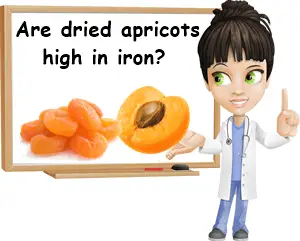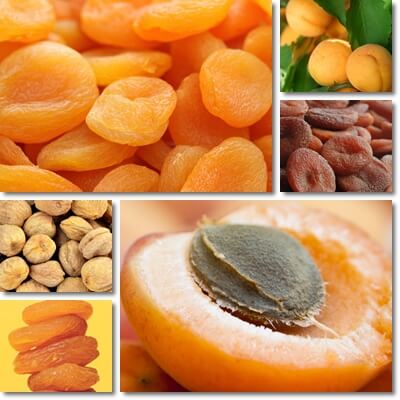Every person who has ever dealt with muscle weakness, low energy levels, tiredness, fatigue and poor concentration will tell you just how important it is to get enough iron in your diet. Both animal foods such as meat and fish, and plant foods such as legumes, nuts, seeds and dried fruit are important sources of iron in a healthy diet. While animal foods provide mostly heme iron, plant foods provide another type of iron known as non-heme iron. Dried apricots are a relatively good source of non-heme iron and provide benefits for muscles, energy metabolism, hair and nail health, as well as benefits for pregnant women.
What is iron good for?
Getting enough iron from your diet means more energy and increased vitality which is good for sustained physical effort and exercise performance. Iron holds particular benefits for athletes and meeting daily requirements supports and boosts athletic performance by increasing oxygen transportation to muscles. The essential dietary mineral is good for the brain and nervous system and boosts concentration and intellectual performance.
Iron is especially good for pregnant women because it helps meet growing demands exerted by the increase in blood volume during pregnancy, restores vitality and combats pregnancy-related fatigue. An adequate intake of the essential mineral during pregnancy promotes the normal cognitive development of the baby and subsequent normal psychomotor development of the infant. Iron is also good for the immune system and actively supports the immune system function.

Symptoms of iron deficiency
The most common symptoms of iron deficiency are muscle weakness, lack of energy and vitality, tiredness and fatigue. What happens when you are low in iron is muscle cells do not get enough oxygen through hemoglobin which causes symptoms such as reduced capacity for physical work and impaired athletic performance as well as muscle twitching, spasms and muscle cramps.
Low iron levels further causes symptoms such as poor concentration, impaired cognitive capacity and intellectual performance, but also lightheadedness, dizziness, irritability, sleep problems such as insomnia and vision problems due to poor oxygen delivery to the brain and nervous system and retina via neuroglobin. Iron deficiency further affects the endocrine system and hormone production and causes hair thinning and hair loss, skin problems such as increased skin infections and poor healing, and nail problems such as brittle nails or changes in nail appearance, color, shape or texture.
Dried apricots iron content
On average dried apricots have about 6.8 times more iron compared to fresh or raw apricots. A serving of 100 g of dried apricots contains 2.66 mg of iron vs 100 g of fresh apricots which provides 0.39 mg of iron. The average adult requires about 18 mg of iron a day which makes dried apricots a relatively good source of the mineral to consider if you are looking to meet your daily requirements.
Also read: Are Dried Apricots High in Potassium?

How high in iron are dried apricots?
A serving of 100 g of dried apricots has 2.66 mg of iron. The average person requires up to 18 mg of iron a day. That means that a serving of 100 g of dried apricots will provide almost 15% of the daily requirements of iron. By comparison, the same amount of fresh apricots provides a little over 2% of the daily requirements of the mineral, which means that dried apricots are quite high in iron compared to raw ones. At the same time, one serving of dried fruit is 25 to 30 grams which would provide 0.665 mg to 0.8 mg of iron. That would amount to only 3.7% of iron – 4.4% of iron per serving of dried apricots, but still higher compared to the fresh fruit.
How many dried apricots should you eat a day?
The average recommended intake of dried fruit is 1-2 servings of 25 to 30 g each. For dried apricots, that would mean you would get 3.7% to 4.4% of your daily iron intake for one serving, and 7.4% to 8.8.% of your daily iron for two servings. That would also mean you would get 16-18 g of carbs and 13.3-16 g of sugar. Depending on your nutritional requirements and any existing conditions that may restrict intake of certain components such as carbohydrates and sugars, you can decide if it’s better for you to reduce intake to one serving of dried apricots, or if you can eat more.
Type of iron in dried apricots
Knowing what kind of iron is in dried apricots is just as important as knowing how much iron is in dried apricots. There are two main types of iron in food: heme iron in animal foods (e.g. meat, fish, seafood such as shellfish, eggs, milk and dairy) and non-heme iron in both animal and plant foods (e.g. fruits such as raw and dried apricots, vegetables, legumes, root vegetables, nuts, seeds).
Dried apricots are a fruit and contain the non-heme type of iron.
Iron absorption rate
On average, a person may absorb as little as 5% of their total iron intake or as much as 35% (the body regulates iron uptake according to its reserves). Heme iron from animal foods has an absorption rate ranging from 15% to 35% (source). Vs heme, non-heme iron in plant foods such as dried apricots has an average absorption rate of 5% to 15%, with some sources putting it as 1% to 10% absorption rate (source 2).
While both heme and non-heme iron contribute to good health, heme iron is the best absorbed of the two types of iron, despite also being the less common form. In an omnivorous diet containing both plant and animal foods, it is estimated that only 5% to 10% of the total iron content is represented by heme iron. Less than half of the iron in meat and other animal foods is heme.
The absorption of non-heme iron from dried apricots and other types of fruit and plant foods can be reduced by several factors (other than pathologies), including:
- A concomitant and excessive intake of calcium, zinc or manganese from other foods or dietary supplements.
- Other components in plant foods with anti-nutrient properties such as phytic acid in legumes or oxalates in spinach and other leafy green vegetables. Anti-nutrients like phytic acid and oxalic acid bind to iron, preventing its absorption at the intestinal level.
Note: Cooking legumes thoroughly and leafy greens for at least 10-15 minutes inactivates anti-nutrients such as oxalates and phytic acid. - Low vitamin C intake, either with the meal or in general.
How to improve the absorption of iron from dried apricots
- Eat dried apricots with a source of vitamin C such as guava fruit, kiwifruit, papaya, mango, pineapple, bell peppers, cantaloupe, tomatoes or fresh kale, broccoli, cauliflower or cabbage.
Note: Dried apricots have almost no vitamin C. As a general rule, cooking heat and drying destroy most, if not all of the vitamin C content in foods. - Take a vitamin C supplement when you eat dried apricots. Natural vitamin C is extracted from acerola cherry, rose hip berries and sea buckthorn berries.
- Eat dried apricots with a source of heme iron such as meat, fish or shellfish. Heme iron boosts absorption of non-heme iron.
What are the benefits of iron in dried apricots?
- Benefits for iron deficiency-anemia. Including dried apricots and other dried fruit, nuts and seeds in your diet helps reverse iron deficiency and combat anemia.
- Minor benefits for muscles. Given the amount and type of iron in dried apricots, there are minor benefits for muscle health such as reduced muscle weakness and improved muscle strength.
- Benefits for tiredness and fatigue. Eating dried apricots can help reverse iron deficiency and combat tiredness and fatigue.
- Restore vitality. Iron, but also potassium, magnesium and other essential nutrients in dried apricots help restore and increase vitality.
- Better concentration. Eating dried apricots helps increase concentration by improving oxygen transportation to the brain and nervous system cells.
- Better sleep. Getting enough iron in your diet from both animal foods (meat, shellfish) and plant foods (legumes, leafy greens and dried fruits such as dry apricots) can have a positive effect on sleep due to improved tissue and cell oxygenation.
- Minor benefits for the heart. By helping restore normal iron levels, dried apricots provide minor benefits for palpitations brought on by iron deficiency anemia.
- Boost in immunity. Eating dried apricots is good for the immune system in more ways: for one, the iron in the dried fruit contributes to the growth and maturation of healthy immune system cells; secondly, it helps make red blood cells and transport oxygen throughout the body, restoring vitality, boosting strength and promoting physical health that favor a faster recovery from infection and disease.
- Benefits for hair. Being iron deficient often causes symptoms such as thinning hair and hair loss, so introducing sources of iron in the diet such as meat and dried apricots can help restore adequate levels of the nutrient and promote hair health.
- Benefits for nails. One of the side effects of iron deficiency and anemia is poor nail health. Getting enough iron in the diet helps reverse the deficiency and improve nail health, strengthening nails and preventing nail deformities.
- Benefits for skin. Iron deficiency affects skin health, causing pale skin due to reduced production of red blood cells. Getting enough iron in the diet restores color to the skin, reduces risks of skin infections by boosting immunity as well as supports the production, differentiation and maturation of new and healthy skin cells.
- Benefits for pregnancy. Eating dried apricots contributes to meeting daily requirements of iron during pregnancy, supporting the increase in blood volume and red blood cell production occurring as a result of normal pregnancy development. Iron further boosts energy levels and restores vitality in pregnant women and has benefits for the normal cognitive development of the baby in the womb and the infant after birth.
